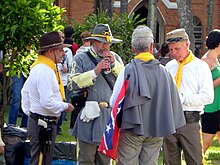 Descendants of Americans during Confederado feast in Santa Bárbara d'Oeste | |
| Total population | |
|---|---|
| 260,000[1] | |
| Regions with significant populations | |
| São Paulo · Espírito Santo · Rio de Janeiro · Paraná · Pará · Minas Gerais · Bahia · Pernambuco | |
| Languages | |
| Brazilian Portuguese • American English and Spanish | |
| Religion | |
| Protestantism and Roman Catholicism and others | |
| Related ethnic groups | |
| Other American and Brazilian people, especially Confederados and other European Americans, Brazilian diaspora in English-speaking countries, other White Latin Americans West and Northern European or Protestant White Brazilians as English, Scottish, Irish, Dutch, Scandinavian, Finnish, Latvian, German (ethnic Germans also among Czech, Russian and Polish immigrants), Austrian, Swiss, French, Luxembourger and Belgian Brazilians |
An American Brazilian (Portuguese: américo-brasileiro, norte-americano-brasileiro, estadunidense-brasileiro) is a Brazilian person who is of full, partial or predominant American descent or a U.S.-born immigrant in Brazil.
The Confederados is a cultural sub-group in the nation of Brazil. They are the descendants of people who emigrated from the Confederate States of America to Brazil with their families after the American Civil War.
At the end of the American Civil War in the 1860s, a migration of Confederates to Brazil began, with the total number of immigrants estimated in the thousands. They settled primarily in Southern and Southeastern Brazil: in Americana, Campinas, São Paulo, Santa Bárbara d'Oeste, Juquiá, New Texas, Xiririca (now Eldorado), Rio de Janeiro and Rio Doce. A few other places also received immigrants: one colony settled in Santarém, Pará – in the north on the Amazon River[2] – and the states of Bahia and Pernambuco also received a significant number of American immigrants.[3]
That was one of the main reasons why emperor Dom Pedro II became the first foreign chief of state and head of government to visit the U.S. capital; he also attended the Centennial Exposition in the largest city in Pennsylvania.[4] More recently, other waves of American nationals became residents in the country.[5]
- ^ US Embassy in Brazil Archived July 13, 2020, at the Wayback Machine US Embassy in Brazil. Retrieved March 29, 2020.
- ^ Confederate Colonies of Brazil Archived May 21, 2008, at the Wayback Machine
- ^ "North American immigrants in Brazil: myth and reality, the case of Santa Barbara" (PDF). Instituto de Economia / UNICAMP. July 29, 2020. Archived from the original (PDF) on May 4, 2021. Retrieved July 29, 2020.
- ^ "Visits to the U.S. by Foreign Heads of State and Government—1874–1939". 2001-2009.state.gov. Archived from the original on March 4, 2016. Retrieved April 13, 2015.
- ^ "Embaixador dos Estados Unidos Todd C. Chapman chega ao Brasil". Embaixada e Consulados dos EUA no Brasil (in European Portuguese). March 29, 2020. Archived from the original on July 13, 2020. Retrieved November 24, 2020.